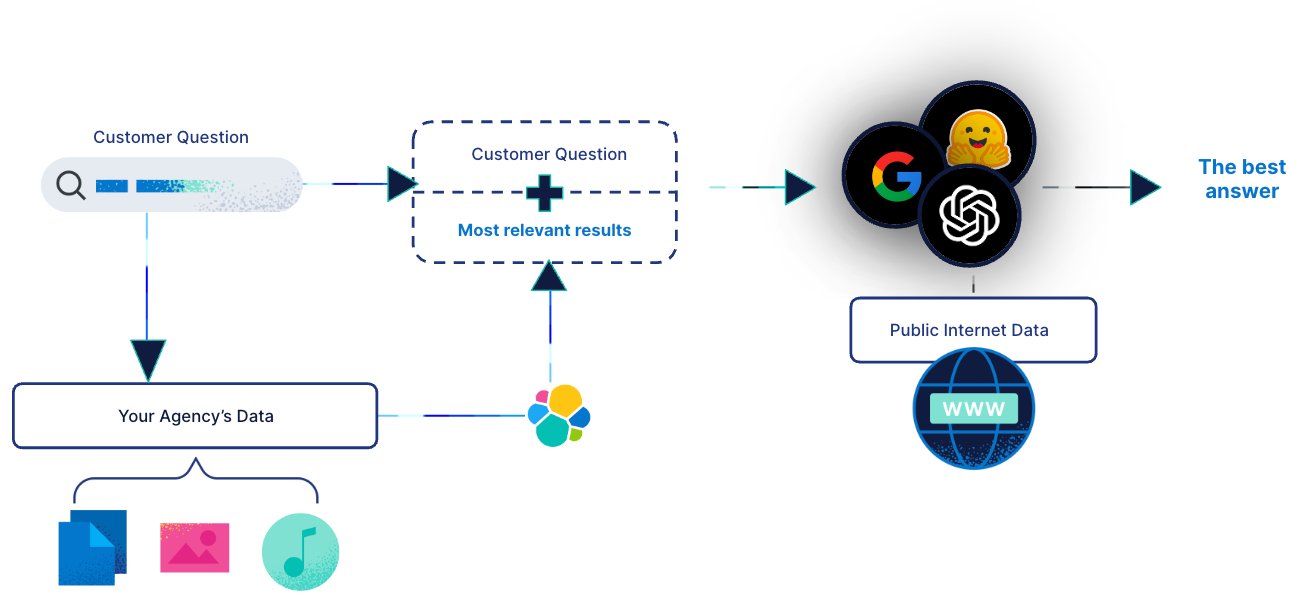Why customer service matters for government — and how AI will help

The pressure is on for government agencies to quickly elevate customer experiences, especially digitally. Customers, in this context, include anyone looking for information, support, or services from federal, state, or local government agencies.
In the US, for example, the federal government is making customer experience a priority for agencies providing high-impact public services. The goal is to “deliver a simple, seamless, and secure customer experience, on par with or better than leading consumer experiences.” Through frameworks such as the one outlined in M-23-22 released this past fall, US federal agencies are being directed to better connect citizens with the right data via on-site search functions and share relevant data across agencies as appropriate.
Consumer-level experiences (or better)
Government agencies have their work cut out for them; consumer expectations have never been higher. Digital interactions must mirror or exceed in-person ones, and consumers expect high levels of customer service and efficiency. Consumers are accustomed to, say, quickly returning the wrong size phone case they ordered online, or cashing a check via their mobile app. From a consumer’s perspective, why wouldn’t the quality of customer service and digital interactions be just as high — or even higher — for issues that have bigger impacts on their livelihoods and well being, such as applying for disaster assistance, signing up for food benefits, or connecting with the right healthcare services?
In this digital, customer-first reality, 90% of consumers expect an immediate response to a customer service issue. This is a high bar, and perhaps more challenging for the public sector to reach. For example, a McKinsey study found that the public sector is ranked lowest of 10 industries for customer satisfaction, and only 8% of Americans say the US government is responsive to the needs of ordinary Americans, according to Pew Research.
Behind the scenes, providing consumer-level customer experiences for public sector can come with outsized obstacles.
Public sector customer service: A uniquely challenging landscape
Unlike in other industries, public sector must serve all people, not a market segment or niche (which often have off-the-shelf technology tools specialized for them). Because of this, agencies must account for customers with accessibility challenges, lack of digital access, geographic distance, language barriers, and generational divides.
Increasing complexity
For citizens, the transition to digitized government brings the new challenges of overwhelming data, options, and digital portals to access help and services. As technology becomes the default for government interaction, call centers are usually the starting point for people who lack the skills or access to navigate a sea of mobile applications and government webpages.
Even the role of a call center is becoming more complex. Just finding the right entry point for a new caller is difficult. Being a call center representative is like being the receptionist for dozens, if not hundreds, of different businesses, all with their own policies and procedures. We've all had the experience of being redirected five times by a call center, impatiently waiting to reach the right person with the right information. It isn't fun.
Keeping track of context and history
From a customer point of view, most time spent with support is verifying your identity and then telling each successive representative what your issue and history is. Getting personalized support is frustrating, because at each turn it's like the government has forgotten everything about you, when realistically they should be the system of record for the problem that needs solving.
Today’s reality is that back-end processes, IT architectures, and data sources are not unified, meaning that customer service agents — and citizens looking for self-service — cannot draw from a complete picture of information. Compounding the issue is the fact that government agencies often work with external mission partners, spanning public-private partnerships, charitable organizations, and other government agencies at the national, state, and local level. All of these partners have their own sources of data.
Customer support, armed with AI comprehension of interaction history and customer details, has the potential to streamline the complexity of government. Imagine if agencies could use all available data to resolve issues and achieve the customer experience revolution called for in our priorities and frameworks. You shouldn't have to tell the government “we already tried that and it didn't work.” The AI should know that and suggest a viable solution to the customer support agent.
The good news is that generative AI is poised to help government agencies deliver faster, more personalized customer service — without putting additional pressure on your internal teams.
Generative AI for next-gen support
Consulting firm BCG estimates that the US public sector will collectively experience $519 billion in productivity gains from generative AI by 2033. In the realm of customer support, generative AI can boost both response time and relevance. The key is implementing these tools responsibly, securely, and with the right contextual data — and this is best done through retrieval augmented generation (RAG).
The importance of RAG for customer support
RAG ensures that generative AI outputs are contextual and relevant to your specific mission and agency. This specificity is enabled by adding a context layer between your agency’s proprietary data and large language models (LLMs), serving as a vital connection between data and generative AI responses. This context layer consists of highly relevant, real-time search results pulled from your own data.
After these search results are filtered into a generative AI application, you end up with better, human-like generative AI responses (in question-answering or chatbot experiences, for example) at a lower cost. Without this critical context (and a way to search and access it), an LLM will only provide minimal value, as it pulls only from the data it’s been trained on (often outdated, publicly available data sets).

Even without data science expertise or machine learning engineers — or the need to spend large sums of money on training or fine-tuning machine learning models — you have options for riding this wave of exciting technology. Search solutions that understand user intent and have flexible AI capabilities built in offer the best of both worlds.
Using search with AI (or “Search AI”), you can take advantage of advanced information-retrieval methods like vector, hybrid, and/or semantic search to surface the best, most accurate, up-to-date data to use in generative AI applications. Powerful, state-of-the-art search can be particularly helpful in connecting end users on your website who are using simple, natural language to look for information. Search AI can securely match user intent with the terms and vernacular that your agency and programs use regularly but may not be on the tip of tongue for an average citizen.
How Elastic’s Search AI Platform can boost customer experience in government
The Search AI Platform harnesses the power of generative AI and search technology to optimize self-service customer support and agent experiences. Use your agency’s proprietary data, knowledge base, and process documentation to provide precise question-answering and recommendations, while maintaining document-level security and keeping costs low.
Here are three benefits of using the Search AI Platform at your agency’s call center or on your website:
Increase access to programs and information via self-service. The US government estimates that $140 billion in potential benefits go unused each year because of “outdated or complicated processes.” Generative AI has the ability to streamline these processes and more directly connect citizens with information and services that they’re looking for. And because 81% of customers attempt self-service before reaching out to a representative, setting up self-service avenues, especially digitally, can take significant pressure off your customer service representatives and create faster ways for people to find what they need directly, especially outside business hours.
- Reduce support time. When citizens choose to interact directly with an agency via a help desk or call center, generative AI can significantly speed time to resolution. With relevant, contextual search and retrieval, customer support agents can resolve support queries faster by surfacing answers and information that are personalized for individuals and their specific needs, instead of spending time starting with generic documents and resources.
AI for customer support can help call center agents immediately find an answer, without needing to pass a customer off to a handful of other people. With real-time access to call scripts and best practices, AI can act as a subject matter assistant for the first person a customer talks to, making them instantly knowledgeable. AI can also help support employees switch context faster and expand to wider topics more easily than a busy call center worker could on their own. - Better understand customers through unified data. Store and unify customer and search data on one platform in order to deliver analysis and insights that your agency can use to improve services and access to them.
When customer support agents are armed with an AI search view of a customer's history of interaction, they can get instant AI access — including summarization and recommendations on how to resolve not just based on the current call but the entire support ticket and history. You shouldn't have to tell the government “we already tried that and it didn't work.” The AI should know that and suggest an alternative for the customer support person to suggest.
From a macro level, agencies can use unified data trends to optimize services and information. You find out what the most searched-for questions are on your agency’s website or what geographic locations these queries are coming from. Ultimately, these patterns can help steer future strategy and direction, aiding your agency in delivering better targeted programs and support or directing content to specific demographics.
As noted on performance.gov, “Improving the public’s trust in government happens transaction by transaction; by understanding our customers’ needs through gathering feedback, conducting research, sharing insights, and testing new approaches to ensure we are designing with our customers every step of the way.”
Getting started with generative AI for government customer experience
Elastic’s Search AI Platform is easy for developers to implement, with full search capabilities for building AI apps and RAG workflows, document-level security, a production-ready vector database, our ELSER pre-trained retrieval model for more relevant semantic search results, and E5 (multi-language) support. Elastic’s open approach allows your team to integrate your data, securely, with your own or third-party transformer models. Contact our team today to walk through your approach and discuss specific next steps.
Related resources:
The release and timing of any features or functionality described in this post remain at Elastic's sole discretion. Any features or functionality not currently available may not be delivered on time or at all.
In this blog post, we may have used or referred to third party generative AI tools, which are owned and operated by their respective owners. Elastic does not have any control over the third party tools and we have no responsibility or liability for their content, operation or use, nor for any loss or damage that may arise from your use of such tools. Please exercise caution when using AI tools with personal, sensitive or confidential information. Any data you submit may be used for AI training or other purposes. There is no guarantee that information you provide will be kept secure or confidential. You should familiarize yourself with the privacy practices and terms of use of any generative AI tools prior to use.
Elastic, Elasticsearch, ESRE, Elasticsearch Relevance Engine and associated marks are trademarks, logos or registered trademarks of Elasticsearch N.V. in the United States and other countries. All other company and product names are trademarks, logos or registered trademarks of their respective owners.